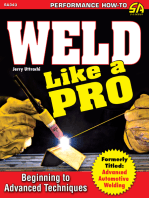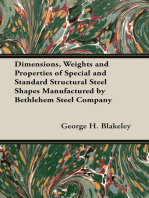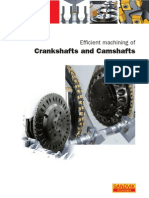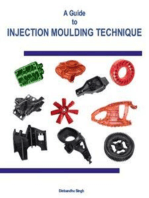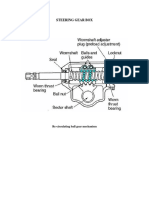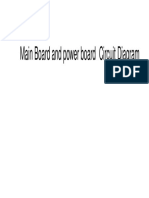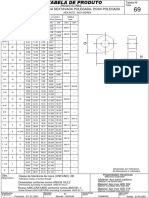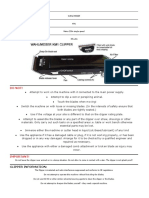19FTM16. Material Properties and Tooth Root Bending Strength of Shot Blasted, Case Carburized Gears With Alternative Microstructures
19FTM16. Material Properties and Tooth Root Bending Strength of Shot Blasted, Case Carburized Gears With Alternative Microstructures
Uploaded by
gioCopyright:
Available Formats
19FTM16. Material Properties and Tooth Root Bending Strength of Shot Blasted, Case Carburized Gears With Alternative Microstructures
19FTM16. Material Properties and Tooth Root Bending Strength of Shot Blasted, Case Carburized Gears With Alternative Microstructures
Uploaded by
gioOriginal Title
Copyright
Available Formats
Share this document
Did you find this document useful?
Is this content inappropriate?
Copyright:
Available Formats
19FTM16. Material Properties and Tooth Root Bending Strength of Shot Blasted, Case Carburized Gears With Alternative Microstructures
19FTM16. Material Properties and Tooth Root Bending Strength of Shot Blasted, Case Carburized Gears With Alternative Microstructures
Uploaded by
gioCopyright:
Available Formats
19FTM16.
Material Properties and Tooth Root Bending Strength of Shot Blasted, Case Carburized Gears with
Alternative Microstructures
Author: Karl Jakob Winkler, Christian Güntner, Thomas Tobie, Karsten Stahl, and Stefan Schurer
Case hardening is one of the most common heat treatment processes for highly loaded components such as
shafts and gears. Due to numerous investigations and according to the material requirements for quality grade
MQ and ME in part 5 of ISO 6336, a microstructure consisting of martensite with less than 30% retained austenite
is favorable for a high load carrying capacity.
A former research project focused on the load carrying capacity of carbonitrided gears with alternative
microstructures. In this research project, the carbonitrided gears with an increased amount of retained austenite of
up to 65% showed a higher tooth flank load capacity than standard case carburized gears. At the same time, the
tooth root bending strength was not influenced in a negative way. The question arises, how different alternative
microstructures influence material properties and thus affect the tooth root bending strength of gears.
This report states the results of current investigations on material properties such as hardness depth profile,
residual stress condition and amount of retained austenite as well as the tooth root bending strength of gear
variants with different alternative microstructures. All gear variants are shot blasted after the heat treatment and
made out of the materials 20MnCr5 and 18CrNiMo7-6.
The tooth root bending strength in the high cycle fatigue regime of these gear variants is not inferior compared to
standard case carburized gears. In the cycle regime of limited life, the tooth root bending strength can be
increased as well as decreased by the alternative microstructures.
As consequence, when regarding the tooth root bending strength, certain alternative microstructures, which are
different to the recommendations of part 5 of the standard ISO 6336, can be tolerated. This means consequently,
that if the tooth root bending strength is tested and acceptable, alternative microstructures can increase the tooth
flank load capacity for shot blasted, case carburized gears.
ISBN: 978-1-64353-055-0
19FTM17. Chamfering of Cylindrical Gears - New Innovative Cutting Solutions for Efficient Gear Production
Author: Gottfried Klein
Cylindrical gear chamfering and deburring is a rather ‘unloved’ process that adds cost but without delivering
readily apparent improvements in gear quality. However, the chamfer process, when performed correctly,
provides significant advantages for downstream handling and processing. This is why manufacturers of
automotive- and truck-sized gears are increasingly exploring new technologies to chamfer their gears.
Two major chamfer technologies are used: forming and cutting. While chamfer rolling is a highly proven forming
process that has been used for decades mainly in mass production, cutting chamfer technologies are of
increasing market interest due to cost reduction and increased quality requirements; especially in dry cutting
conditions.
This paper will cover new chamfer cutting processes: Chamfer Contour Milling and Chamfer Hobbing and
compare them with the existing chamfer roll technology.
Chamfer Contour Milling uses a universal fly cutter tool with indexable carbide inserts. Chamfer angle and
chamfer size depend on programmable machine movements. Therefore, this process provides highest flexibility
for coarse pitch gears – even with different modules, pressure angles or number of teeth.
Chamfer Hobbing has been developed for modern gear production focusing on low tool cost per part with dry
cutting and short cycle times in mass production. As for the left and right gear flank, separate and dedicated
chamfer hobs are used to meet most customer specifications in the market.
By comparing the advantages and limits of the aforementioned chamfer processes in gear production for
workpieces up to 400 mm diameter and module 8 mm, it is possible to select the right process depending on the
specific requirements.
ISBN: 978-1-64353-056-7
Obsolete documents should not be used; please use replacements. Most obsolete and superseded documents are
available for purchase. Contact AGMA Headquarters for pricing and availability.
AGMA Publications Catalog 37 April 2020
You might also like
- DEC - 10 - RAJIV - PAPER Geearless Vs Geared Mill Drives PROCEMINNo ratings yetDEC - 10 - RAJIV - PAPER Geearless Vs Geared Mill Drives PROCEMIN12 pages
- Performance Exhaust Systems: How to Design, Fabricate, and Install: How to Design, Fabricate, and InstallFrom EverandPerformance Exhaust Systems: How to Design, Fabricate, and Install: How to Design, Fabricate, and Install4/5 (8)
- Dimensions, Weights and Properties of Special and Standard Structural Steel Shapes Manufactured by Bethlehem Steel CompanyFrom EverandDimensions, Weights and Properties of Special and Standard Structural Steel Shapes Manufactured by Bethlehem Steel CompanyNo ratings yet
- ANSI/AGMA 2009-B01. Reaffirmed March 2014.: ISBN: 1-55589-926-4 Pages: 23No ratings yetANSI/AGMA 2009-B01. Reaffirmed March 2014.: ISBN: 1-55589-926-4 Pages: 231 page
- 19FTM18. Influence of Manufacturing Variations of Spline Couplings On Gear Root and Contact StressNo ratings yet19FTM18. Influence of Manufacturing Variations of Spline Couplings On Gear Root and Contact Stress1 page
- ISBN: 1-55589-067-4 Pages: 16: AGMA Publications Catalog 52 April 2020No ratings yetISBN: 1-55589-067-4 Pages: 16: AGMA Publications Catalog 52 April 20201 page
- 2016 PAPERS: ISBN: 1-55589-060-5 Pages: 13No ratings yet2016 PAPERS: ISBN: 1-55589-060-5 Pages: 131 page
- Crankshafts and Camshafts: Efficient Machining ofNo ratings yetCrankshafts and Camshafts: Efficient Machining of20 pages
- SPE 93856 Cutting-Edge Materials Technology Elevates Drilling Performance in Soft-Formation ApplicationsNo ratings yetSPE 93856 Cutting-Edge Materials Technology Elevates Drilling Performance in Soft-Formation Applications12 pages
- New Finishing Mill Technology For The Production of Thin Hot BandNo ratings yetNew Finishing Mill Technology For The Production of Thin Hot Band8 pages
- Update On JHEP SAG Mill Drive SelectionNo ratings yetUpdate On JHEP SAG Mill Drive Selection20 pages
- Hard Turning of Hot Work Tool Steel (Dac10)No ratings yetHard Turning of Hot Work Tool Steel (Dac10)38 pages
- ColceruM-Designing With Plastic Gears and General Considerations of Plastic GearingNo ratings yetColceruM-Designing With Plastic Gears and General Considerations of Plastic Gearing10 pages
- Parts and More Compact Picks: Road and Mineral TechnologiesNo ratings yetParts and More Compact Picks: Road and Mineral Technologies56 pages
- Timken Split Cylindrical Roller Bearing Housed Units 10803No ratings yetTimken Split Cylindrical Roller Bearing Housed Units 1080368 pages
- Whitepaper: The Reinvention of The Gear CouplingNo ratings yetWhitepaper: The Reinvention of The Gear Coupling4 pages
- Experience With Large, High-Speed Load Gears: Erwin Dehner and Francois WeberNo ratings yetExperience With Large, High-Speed Load Gears: Erwin Dehner and Francois Weber11 pages
- The Ford SOHC Pinto & Sierra Cosworth DOHC Engines high-peformance manual: For Road & TrackFrom EverandThe Ford SOHC Pinto & Sierra Cosworth DOHC Engines high-peformance manual: For Road & TrackNo ratings yet
- Bearings And Bearing Metals: A Treatise Dealing with Various Types of Plain Bearings, the Compositions and Properties of Bearing Metals, Methods of Insuring Proper Lubrication, and Important Factors Governing the Design of Plain BearingsFrom EverandBearings And Bearing Metals: A Treatise Dealing with Various Types of Plain Bearings, the Compositions and Properties of Bearing Metals, Methods of Insuring Proper Lubrication, and Important Factors Governing the Design of Plain Bearings4/5 (1)
- How to Power Tune the BMC/BL/Rover 998 A-Series Engine for Road and TrackFrom EverandHow to Power Tune the BMC/BL/Rover 998 A-Series Engine for Road and TrackNo ratings yet
- The Beginners Guide to Band Saws: Manual on how to Choose, Install, Maintain and Troubleshooting Tips for your Bandsaw with Basic ProjectsFrom EverandThe Beginners Guide to Band Saws: Manual on how to Choose, Install, Maintain and Troubleshooting Tips for your Bandsaw with Basic ProjectsNo ratings yet
- Spot Welding Interview Success: An Introduction to Spot WeldingFrom EverandSpot Welding Interview Success: An Introduction to Spot WeldingNo ratings yet
- ISBN: 1-55589-547-1 Pages: 15: AGMA Publications Catalog 48 April 2020No ratings yetISBN: 1-55589-547-1 Pages: 15: AGMA Publications Catalog 48 April 20201 page
- 19FTM14. 4D High Pressure Gas Quenching - A Leap in Performance vs. Press QuenchingNo ratings yet19FTM14. 4D High Pressure Gas Quenching - A Leap in Performance vs. Press Quenching1 page
- 19FTM03. Spline Centering, Piloting, and Toggle: Torsional Stiffness, Shaft Bending, and Centering of Moment LoadsNo ratings yet19FTM03. Spline Centering, Piloting, and Toggle: Torsional Stiffness, Shaft Bending, and Centering of Moment Loads1 page
- 19FTM05. Design of A Double Spiral Bevel Gearset: ISBN: 978-1-64353-044-4No ratings yet19FTM05. Design of A Double Spiral Bevel Gearset: ISBN: 978-1-64353-044-41 page
- TR13989-1:2000 Calculation of Scuffing Load Capacity of Cylindrical, Bevel and Hypoid GearsNo ratings yetTR13989-1:2000 Calculation of Scuffing Load Capacity of Cylindrical, Bevel and Hypoid Gears1 page
- 1 Purpose of Revision 1. Purpose of Revision: Front Axle Assembly TransmissionNo ratings yet1 Purpose of Revision 1. Purpose of Revision: Front Axle Assembly Transmission3 pages
- Threaded Devices: ME3180 Wayne Book From Norton, Machine Design and Budynas & Nisbett MechanicalNo ratings yetThreaded Devices: ME3180 Wayne Book From Norton, Machine Design and Budynas & Nisbett Mechanical23 pages
- 12 370164 Ss SWFF Reducing Flange, Astm A182 F316/316L Size: 1" X 1/2" X #150No ratings yet12 370164 Ss SWFF Reducing Flange, Astm A182 F316/316L Size: 1" X 1/2" X #1503 pages
- Assignment 2 Statically Determinate structureNo ratings yetAssignment 2 Statically Determinate structure6 pages
- TOPHOUSE - KONKA KDL32MD662LN - Diagrama Placa Única Principal y Fuente.100% (1)TOPHOUSE - KONKA KDL32MD662LN - Diagrama Placa Única Principal y Fuente.13 pages
- Pulling Pipe (Driller) : Cormorant Alpha Drilling Operations GuideNo ratings yetPulling Pipe (Driller) : Cormorant Alpha Drilling Operations Guide10 pages
- Porca Sextavada Polegada - Posx PolegadaNo ratings yetPorca Sextavada Polegada - Posx Polegada1 page
- DT Test For Qualifications-WPS - PQR-AsmeNo ratings yetDT Test For Qualifications-WPS - PQR-Asme14 pages
- CLASS 63421: DEP 31.38.01.14-Gen Class 63421, Rev. K Page 1 of 13No ratings yetCLASS 63421: DEP 31.38.01.14-Gen Class 63421, Rev. K Page 1 of 1313 pages





